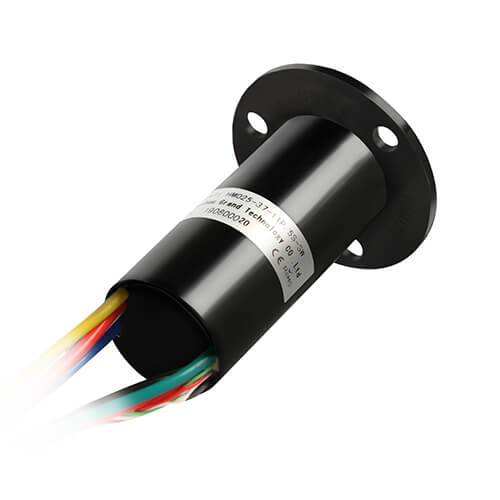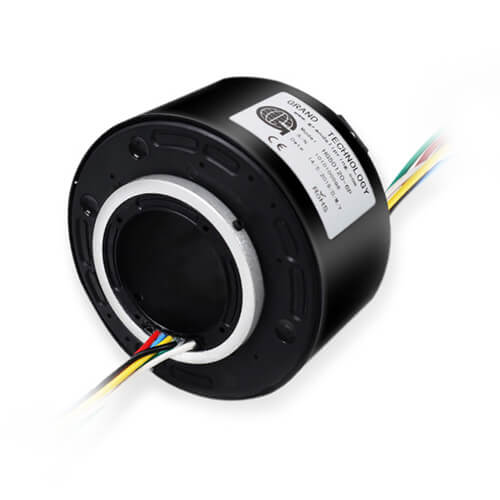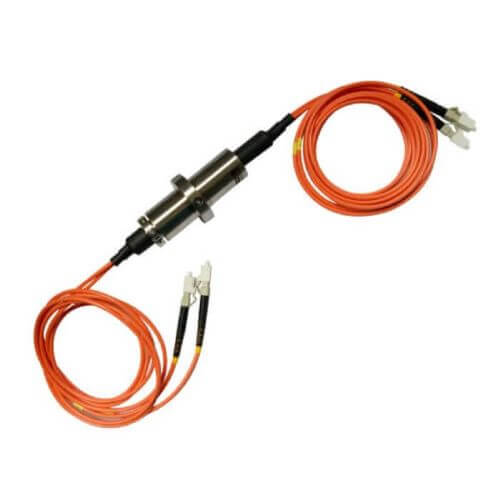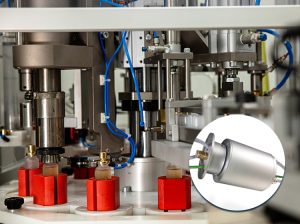Introduction
Industrial automation has revolutionized the manufacturing sector with its innovative technologies, efficient mechanisms, and customized solutions. One such prominent component in automation equipment is the slip ring. This comprehensive guide will discuss the various aspects of slip rings, their impacts on automation equipment, current applications & industry trends, and future predictions, and address frequently asked questions.
Basics of Slip Rings in Industrial Automation

As we dive into the world of Industrial Automation, slip rings emerge as fundamental components enabling power and data continuity, and facilitating the operation of rotating machinery parts. In essence, they ensure that automated tasks can be accomplished with higher efficiency and productivity. This section will introduce the basic concept of slip rings and will articulate their diverse types and corresponding applications.
Definition
A slip ring formally referred to as a rotary electrical interface, rotating electrical connector, or electrical rotary joint, is an electromechanical device that allows the continuous transmission of power and electrical signals from a stationary structure to a rotating component. It aids in simplifying system operation, enhancing mechanical performance, eliminating damage-prone wires, and improving overall system reliability. Specifically, in the realm of industrial automation, this precise, uninterrupted power transmission facilitates operations such as 360-degree rotation in a variety of equipment like motors, turbines, and drones. Fundamental to a multitude of applications, the slip ring aids in the seamless integration of subsystems within complex automation systems.
Types of Slip Rings and Their Applications
A diverse range of slip rings exists, each designed to cater to the specific requirements of different devices and applications in industrial automation:
Capsule Slip Rings

At a glance, these appear compact and sleek in design, making them suitable for transmitting signals in small- to medium-sized automation devices, such as medical imaging devices, cable reels, test equipment, and closed-circuit camera systems. Despite their small form, they possess the capability to carry a range of currents and support multiple channels.
Through Bore Slip Rings

Distinguished by their central hole, or ‘through-bore,’ these slip rings accommodate cables, shafts, and other connections that need to pass through the middle. Large-scale machinery, like wind turbines, packaging machinery, rotary tables, and other automation equipment, frequently employ through-bore slip rings due to their robustness and versatility.
Pancake Slip Rings

Characterized by their flat, disc-like structure, these are primarily used in applications where space is restricted but high performance is required. Pancake slip rings find their applications where lengthwise space is limited, like radar systems, rotating tanks, control towers, and automated rotating doors.
Mercury-wetted Slip Rings
Unique in their use of liquid metal, specifically mercury, these slip rings ensure very low contact resistance and are associated with high-speed and high-frequency applications. They are found in laboratory equipment, process machinery, index tables, and machines that require fast rotating speed with stable signal transmission.
Fiber Optic Slip Rings (FORJ)

These slip rings are tuned to transmit optical signals, along with power and data signals. They are essential for applications dependent on high-speed data communication and support the increasing demand for fiber optic connections in automation systems. You’ll typically come across FORJ in remote-operated vehicles (ROVs), broadcasting equipment, and high-speed cameras.
Impact of Slip Rings on Automation Equipment
The integration of slip rings in automation equipment reaps numerous benefits, from improved efficiency and productivity to enhanced flexibility and reliability. As supportive components in complex systems, slip rings foster innovation and advancements in industrial automation. This section elaborates upon their impact, including improved efficiency, flexibility, and reduced downtime.
Improved Efficiency and Productivity
Slip rings play a vital role in streamlining complex processes in automation equipment. By allowing continuous power and signal transmission between stationary and rotating components, they facilitate smooth, uninterrupted operations, leading to increased precision and accuracy in various tasks. This heightened level of efficiency directly affects the productivity of the entire system by reducing production cycle times and waste, thus maximizing resource utilization and output. Consequently, the adoption of slip rings in industrial automation leads to higher productivity levels and overall business success.
Enhanced Flexibility and Adaptability
Flexibility and adaptability are essential for versatile automation equipment, capable of handling a wide variety of applications and tasks efficiently. Slip rings contribute to this versatility by enabling a broader range of motion and allowing the integration of different designs and configurations, catering to specific industry needs. For instance, adjustable through-bore slip rings can accommodate varying shaft sizes, while customizable contact points streamline communication between rotating parts in multi-axis robotic applications. This flexibility encourages innovation and fosters growth by enabling industrial automation equipment to adapt to new processes, tools, and changing market demands.
Reduced Downtime and Maintenance
Utilizing robust, high-quality slip rings directly translates to less wear and tear on equipment, causing a decrease in system downtime events and minimizing the need for frequent maintenance checks. In turn, this reduces both the direct costs associated with servicing and the indirect costs of lost production due to equipment breakdowns. Additionally, well-designed slip rings prolong the lifespan of the machinery by minimizing electrical noise and ensuring an uninterrupted supply of power and signals. As a result, the overall reliability and cost-efficiency of the industrial automation equipment are significantly improved.
Current Applications and Industry Trends
The global industry currently witnesses the transformative role of slip rings in automation applications. Given their ability to ensure seamless power and data transmission between stationary and rotating parts, they have become an essential component in a multitude of applications across various automation verticals. This section will delve deeper into the ongoing integration of slip rings in industry trends ranging from robotic manufacturing to process control.
Robotic Manufacturing Cells and Assembly Lines

In the domain of robotic manufacturing and assembly lines, slip rings make a significant impact by enabling 360-degree continuous rotation of robotic arms and joints. This unrestricted motion allows robots to perform complex tasks that require multi-axis rotation, leading to improved manufacturing quality and speed. Slip rings, especially those designed for high-speed data transmission, also facilitate real-time communication and control in robotic assemblies, thereby ensuring precision and reducing the likelihood of errors. This trend of integrating slip rings into robotic manufacturing continues to revolutionize industries such as automotive, electronics, and aerospace, which rely heavily on automated assembly lines.
Packaging and Material Handling Systems

Packaging and material handling systems are increasingly embracing the use of slip rings to optimize their operations. These systems often involve rotating parts, such as conveyors, wrapping machines, and sorting devices, where slip rings ensure uninterrupted function. They play a vital role in maintaining constant power supply and signal transmission, even in high-speed applications, enhancing the efficiency and reliability of the entire system. This sophisticated level of automation helps businesses manage high-volume packaging tasks more effectively and bolsters overall production efficiency.
Automated Test and Inspection Equipment
In automated test and inspection equipment, slip rings not only facilitate the free rotation of testing components such as probes and sensors but also aid in the seamless transmission of real-time inspection data. This ability to convey information during testing operations offers an enormous advantage as it allows for rapid, accurate defect detection and quality assessment, thereby reducing the rate of faulty products and enhancing product quality.
Automated Process Control and Monitoring

Automated process control and monitoring are becoming vital for efficient plant management in industries such as oil and gas, power generation, and wastewater treatment. Slip rings integrated into these control systems ensure uninterrupted power and signal transmission, crucial for real-time monitoring, accurate data collection, and precise control of process parameters. By minimizing the chances of communication loss, slip rings significantly foster the reliability of automated control systems, thereby boosting overall operational performance and safety.
Future Predictions and Trends
As technological advancements shape the future of industries, slip rings are expected to continue playing a pivotal role in the evolution of automated equipment. Trends and predictions indicate that the usage of slip rings will experience significant growth due to the high demand for improved operational efficiencies, data continuity, and precision in the automation sphere.
The advent of digitalization, driven by the convergence of Industry 4.0, artificial intelligence, and the Internet of Things (IoT), opens new avenues for the integration of slip rings. Smart slip rings, equipped with built-in sensor systems for real-time data acquisition and continuous monitoring, are likely to be at the forefront. These advanced slip rings could provide significant advantages in predictive maintenance and condition monitoring by enabling the early detection of issues and preventing sudden machine failures.
Simultaneously, the miniaturization trend in many technology sectors will likely influence slip ring designs, pushing manufacturers to develop compact but powerful slip rings that can efficiently operate in restricted spaces without compromising performance. As applications such as micro-drones, miniature satellites, and medical devices continue to miniaturize, the demand for small-sized yet capable slip rings is poised to surge.
At the heart of many renewable energy applications, like wind turbines and solar trackers, slip rings provide essential transfer of power and signals during operations. As global efforts to transition towards sustainable energy sources intensify, an influx in the usage of slip rings in these renewable energy projects can be anticipated, contributing further to their market expansion.
Moreover, the transition towards fiber optics for high-speed, high-bandwidth applications will drive the demand for Fiber Optic Rotary Joints (FORJs). FORJs support the increasing need for reliable, high-speed data transmission in several end-use industries such as telecommunications, aerospace, and defense.
Looking ahead, these aforementioned trends highlight the significant untapped potential and unexplored applications for slip rings. It’s clear that as industries increasingly automate and modernize their operations, slip rings will stay at the forefront, underpinning new levels of efficiency, versatility, and reliability.
User-Interest Areas
In the realm of slip rings, it is essential to address key user-interest areas revolving around customization, durability, supplier selection, and adherence to standards and regulations. These factors play a significant role in ensuring that the slip rings effectively fulfill their intended purpose while providing reliability, efficiency, and compliance with industry specifications. This section delves deeper into these user-interest areas, ensuring a comprehensive understanding of what users need to consider when integrating slip rings into their automation systems.
Customization and Design
One of the primary concerns of users when adopting slip rings is the customization and design according to their specific application needs. Customized slip rings enable a seamless fit within the users’ systems, ensuring that power and signal transmission remain uninterrupted during rotation-related operations. To cater to these requirements, manufacturers of slip rings increasingly offer bespoke design options, including modularity and material selection, to satisfy unique end-use applications. Users must vividly communicate their application needs, operational constraints, and performance expectations to manufacturers or suppliers, ultimately enabling the successful development of tailor-made slip rings that meet their requirements.
Durability, Maintenance, and Lifespan
Another critical user-interest area relates to the durability, maintenance, and lifespan of slip rings. Users seek reliable, robust solutions that not only ensure optimal performance during operation but also offer excellent service life. Regular maintenance, as well as accurate monitoring of slip ring performance, are essential in prolonging the lifespan of these components and reducing the risk of sudden failures.
When selecting slip rings, users should inquire about maintenance schedules and the availability of replacement parts to avoid prolonged downtime. Additionally, it is crucial to understand the environmental and operational factors that may affect the slip ring’s durability and adjust their expectations accordingly.
Product Selection and Supplier Relationships
Establishing a strong relationship with the slip ring manufacturer (Top 10 Slip Ring Manufacturers in China, Top 10 Slip Ring Manufacturers In the USA Market 2023, and Top 10 Slip Ring Industry Key Manufacturers 2023)or supplier is vital for users, as it enables transparent communication and ensures that users receive guidance and support throughout the slip ring’s lifecycle. Selecting a reputable slip ring supplier ensures that users receive high-quality, dependable components that comply with industry standards.
Furthermore, a reliable supplier will provide detailed documentation, technical support, and assistance in selecting the right slip ring for the application. Developing a long-term partnership with a trusted supplier guarantees a reliable source for maintenance, support, and future product upgrades.
Standards, Regulations, and Compliance
Slip rings must abide by specific standards, regulations, and compliance requirements to ensure safe and efficient operation within the user’s automation systems. These standards and regulations might vary depending on the application, industry, and region in which the slip rings are employed.
Users should acquaint themselves with the necessary standards and certifications required for their applications and ensure that their selected slip rings comply with these regulations. Manufacturers should provide the relevant documentation, test results, and certifications that demonstrate compliance with the governing standards, offering users peace of mind that the slip rings will function safely and reliably within their systems.
Conclusion
In conclusion, the function of slip rings as essential components in automation equipment spans a broad range of applications. Having expedited advances in sectors like robotic manufacturing, packaging systems, automated testing, and process controls, they ensure seamless operations and reduce downtime. Projecting into the future, they are predicted to play a greater role driven by the advent of technologies like Industry 4.0, IoT, and AI. Meanwhile, their integration into sustainable energy applications like wind turbines and solar trackers is also set to increase.
Recognizing these effects and potential trends, it’s crucial that users carefully consider their specific needs such as customization, maintenance, supplier relationships, and standards compliance. Ultimately, slip rings hold an increasing significance in fostering efficiency, versatility, and reliability in the automation industry. Their critical role in interfacing rotating and stationary components is set to rise as automation permeates modern industries even further.
FAQs about Slip Rings Applications in Industrial Automation
Q: What factors should be considered when selecting a slip ring?
A: Key factors include rotation speed, system voltage and current, device dimensions, operating environment, and application-specific requirements.
Q: How do I know when slip rings need replacement or maintenance?
A: Indicators such as increased electrical noise, fluctuating signals, and intermittent connectivity issues often signify wear or failure and should prompt a maintenance check.
Q: Can slip rings operate in extreme environments?
A: Many slip rings are designed to withstand harsh operating conditions, such as high temperature, humidity, or vibrations, depending on the application.
Q: Are there any alternatives to slip rings?
A: Alternative solutions include traditional cable reels, inductive and capacitive couplers, and wireless communication technologies. However, these options may have limitations compared to slip rings, depending on the application.
See What We Can Do

